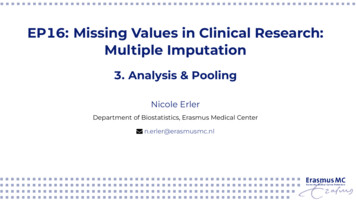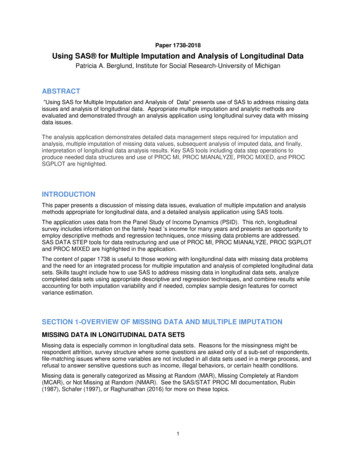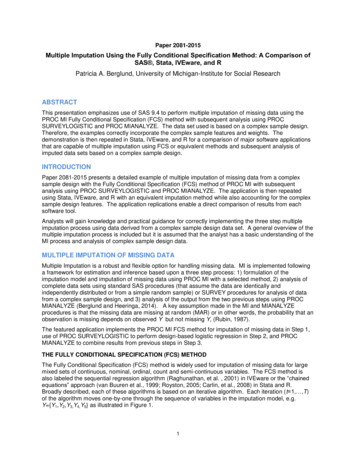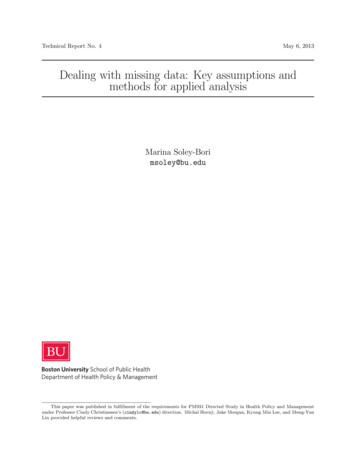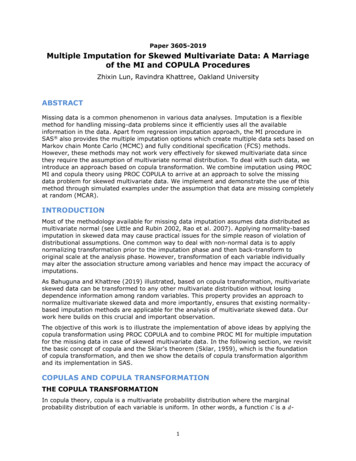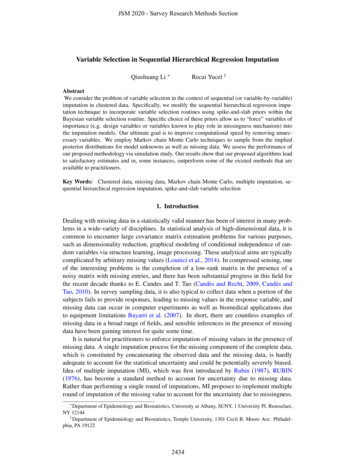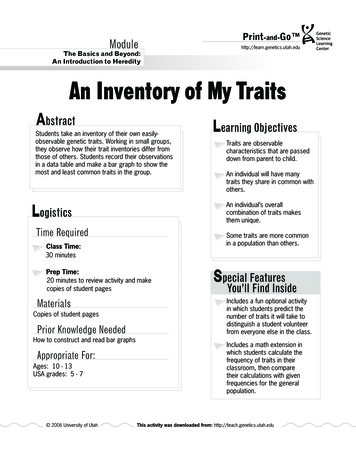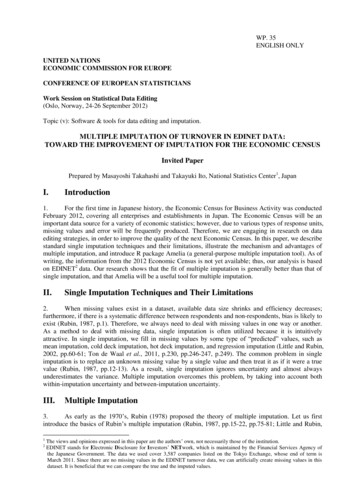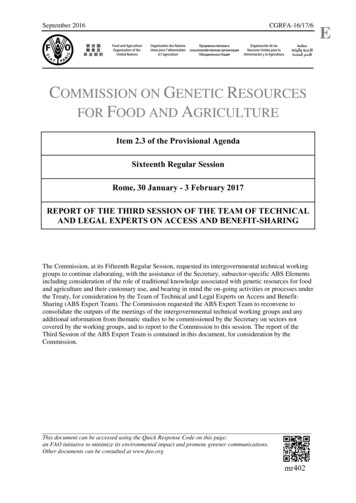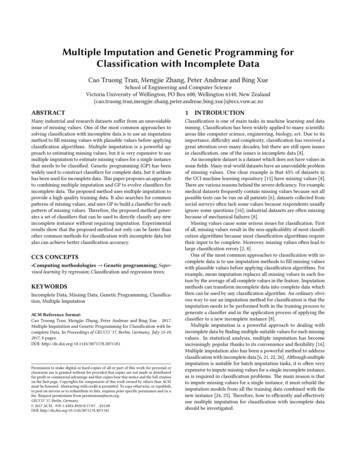
Transcription
Multiple Imputation and Genetic Programming forClassification with Incomplete DataCao Truong Tran, Mengjie Zhang, Peter Andreae and Bing XueSchool of Engineering and Computer ScienceVictoria University of Wellington, PO Box 600, Wellington 6140, New e,bing.xue}@ecs.vuw.ac.nzABSTRACT1Many industrial and research datasets suffer from an unavoidableissue of missing values. One of the most common approaches tosolving classification with incomplete data is to use an imputationmethod to fill missing values with plausible values before applyingclassification algorithms. Multiple imputation is a powerful approach to estimating missing values, but it is very expensive to usemultiple imputation to estimate missing values for a single instancethat needs to be classified. Genetic programming (GP) has beenwidely used to construct classifiers for complete data, but it seldomhas been used for incomplete data. This paper proposes an approachto combining multiple imputation and GP to evolve classifiers forincomplete data. The proposed method uses multiple imputation toprovide a high quality training data. It also searches for commonpatterns of missing values, and uses GP to build a classifier for eachpattern of missing values. Therefore, the proposed method generates a set of classifiers that can be used to directly classify any newincomplete instance without requiring imputation. Experimentalresults show that the proposed method not only can be faster thanother common methods for classification with incomplete data butalso can achieve better classification accuracy.Classification is one of main tasks in machine learning and datamining. Classification has been widely applied to many scientificareas like computer science, engineering, biology, ect. Due to itsimportance, difficulty and complexity, classification has received agreat attention over many decades, but there are still open issuesin classification, one of the issues is incomplete data [8].An incomplete dataset is a dataset which does not have values insome fields. Many real-world datasets have an unavoidable problemof missing values. One clear example is that 45% of datasets inthe UCI machine learning repository [15] have missing values [8].There are various reasons behind the severe deficiency. For example,medical datasets frequently contain missing values because not allpossible tests can be run on all patients [6]; datasets collected fromsocial surveys often lack some values because respondents usuallyignore some questions [16]; industrial datasets are often missingbecause of mechanical failures [8].Missing values cause some serious issues for classification. Firstof all, missing values result in the non-applicability of most classification algorithms because most classification algorithms requiretheir input to be complete. Moreover, missing values often lead tolarge classification errors [2, 8] .One of the most common approaches to classification with incomplete data is to use imputation methods to fill missing valueswith plausible values before applying classification algorithms. Forexample, mean imputation replaces all missing values in each feature by the average of all complete values in the feature. Imputationmethods can transform incomplete data into complete data whichthen can be used by any classification algorithm. An ordinary obvious way to use an imputation method for classification is that theimputation needs to be performed both in the training process togenerate a classifier and in the application process of applying theclassifier to a new incomplete instance [8].Multiple imputation is a powerful approach to dealing withincomplete data by finding multiple suitable values for each missingvalues. In statistical analysis, multiple imputation has becomeincreasingly popular thanks to its convenience and flexibility [16].Multiple imputation also has been a powerful method to addressclassification with incomplete data [6, 21, 22, 26]. Although multipleimputation is suitable for batch imputation tasks, it is often veryexpensive to impute missing values for a single incomplete instance,as is required in classification problems. The main reason is thatto impute missing values for a single instance, it must rebuild theimputation models from all the training data combined with thenew instance [24, 25]. Therefore, how to efficiently and effectivelyuse multiple imputation for classification with incomplete datashould be investigated.CCS CONCEPTS Computing methodologies Genetic programming; Supervised learning by regression; Classification and regression trees;KEYWORDSIncomplete Data, Missing Data, Genetic Programming, Classification, Multiple ImputationACM Reference format:Cao Truong Tran, Mengjie Zhang, Peter Andreae and Bing Xue . 2017.Multiple Imputation and Genetic Programming for Classification with Incomplete Data. In Proceedings of GECCO ’17, Berlin, Germany, July 15-19,2017, 8 pages.DOI: n to make digital or hard copies of all or part of this work for personal orclassroom use is granted without fee provided that copies are not made or distributedfor profit or commercial advantage and that copies bear this notice and the full citationon the first page. Copyrights for components of this work owned by others than ACMmust be honored. Abstracting with credit is permitted. To copy otherwise, or republish,to post on servers or to redistribute to lists, requires prior specific permission and/or afee. Request permissions from permissions@acm.org.GECCO ’17, Berlin, Germany 2017 ACM. 978-1-4503-4920-8/17/07. . . 15.00DOI: ION
GECCO ’17, July 15-19, 2017, Berlin, GermanyGenetic programming (GP) is an evolutionary technique [14].The capability of GP in learning the definition of a function fromexamples makes it a good choice for evolving good classifiers. Therefore, GP has been widely used to classification tasks [4].Although GP has been successfully used to learn classifiers, ithas been mainly applied to complete data. Since standard GP cannot work directly with incomplete data, imputation methods areoften required to transform incomplete data into complete databefore using GP [23]. However, the combination of GP and a simple imputation method such as mean imputation often leads to aweak classifier. Therefore, GP needs be combined with a sophisticated imputation method such as multiple imputation to evolvea good classifier. Unfortunately, applying multiple imputation toclassification with incomplete data in the ordinary obvious way isvery inefficient [24]. Therefore, how to effectively and efficientlycombine GP and multiple imputation also should be investigated.1.1Research goalsThe goal of this paper is to propose a method combining multipleimputation with GP to evolve classifiers for incomplete data thatallow efficient and effective classification. To achieve this goal,multiple imputation is used to transform the training incompletedata to the training complete data. Furthermore, the proposedmethod identifies all common patterns of missing values. Afterthat, GP is used to learn a classifier for each pattern of missingvalues. As a result, the proposed method builds a set of classifierwhich can be then used to directly classify incomplete instanceswithout using any imputation. The proposed method is comparedwith other common combinations of GP and imputation methodswhich use imputation methods to estimate missing values for boththe training set and the test set. Experimental results are used toshow that:(1) The proposed method can achieve better classification accuracy than the other combinations of GP and imputationmethods, and(2) The proposed method can be faster to classify incompleteinstances than the other combinations of GP and imputation methods.1.2OrganisationThe rest of the paper is organised as follows. Section 2 discussesrelated work. Section 3 shows the proposed method. Section 4presents the experiment design. Section 5 states experimental results and analysis. Finally, section 6 makes conclusions and mentions future work.2RELATED WORKThis section presents related work including imputation methodsand GP for classification.2.1Imputation MethodsThe purpose of imputation methods is to transform incompletedata into complete data by replacing missing values with plausiblevalues. Because a majority of classification algorithms requirecomplete data, using imputation methods is a main approach toaddressing classification with incomplete data. A traditional way toCao Truong Tran, Mengjie Zhang, Peter Andreae and Bing Xueuse an imputation method for classification with incomplete data isthat the imputation method is used to estimate missing values forboth the training data and a new incomplete instance that needsbe classified in the application process [8].Imputation methods can be divided into single imputation methods and multiple imputation methods. While single imputationmethods estimate one value for each missing value, multiple imputation methods estimate multiple values for each missing value[16].2.1.1 Single imputation. Single imputation methods try to findone suitable value for each missing value. Two single commonimputation methods are hot deck imputation and Knn-based imputation [5].Hot deck imputation replaces missing values for an incompleteinstance by searching the most similar with the incomplete instance,and then filling missing values with the complete values in the mostsimilar instance. This method can replace missing values by realvalues. However, it only uses the information of one instance;therefore, it ignores global properties of the data [1].Knn-based imputation is based on K-nearest neighbors algorithm.To replace missing values for each incomplete instance, firstly, itsearches the K most similar instances with the incomplete instance,and then replaces missing values of the incomplete instance withthe average of complete values in the K most similar instances. Knnbased imputation often performs better than hot deck imputation.However, this method is often computationally intensive becauseit has to search through all instances to find the K most similarinstances for each incomplete instance [2].2.1.2 Multiple imputation. Multiple imputation methods tryto find a set of suitable values for each missing value. Multipleimputation is often computationally more expensive than singleimputation. However, multiple imputation has becomes more andmore popular. The main reason is that multiple imputation often reflects better the uncertainty of missingness [6, 21, 22, 26]. Moreover,many recent software developments have based on the multipleimputation framework [10].MICE [27] is one of the most advanced multiple imputationmethods. MICE uses some regression models to predict missingvalues. Firstly, each missing field is randomly replaced with onecomplete value in the same feature. Next, each incomplete featureis estimated on other features to build a better estimation for thefeature. The process is done several times for all incomplete featuresto produce one imputed dataset. The whole procedure is done Ntimes (N 1) to produce N imputed datasets. Finally, the N imputeddatasets are averaged to make the final imputed dataset.Multiple imputation is originally designed for statistical analysistasks [16]. Multiple imputation also has been demonstrated as apowerful imputation approach to estimating missing values forclassification with incomplete data [6, 26]. Multiple imputationis suitable for batch imputation, so it is efficient to estimate missing values for the training data. However, multiple imputation iscomputationally expensive to estimate missing values for singleincomplete instance that needs be classified in the application process [24]. Therefore, an effective and efficient way to apply multipleimputation for classification with incomplete data should be moreinvestigated.
Multiple Imputation and Genetic Programming for Classification with Incomplete Data2.2Genetic Programming for ClassificationGP has been widely used to construct discriminant functions forclassification tasks. A discriminant function is a mathematicalexpression that represents a combination of the features of aninstance which needs be classified. The value returned by thediscriminant function determines the predicted class by using asingle threshold or a set of thresholds. The obvious way to constructdiscriminant functions by using GP is that each individual in GPpopulation represents one discriminant function. The function setof GP is able to contain any type of functions and operations whichis able to work on the data. GP has been used to construct bothbinary discriminant functions and multiple discriminant functions[4].With binary classification problems, one discriminant functionis adequate to distinguish two classes. When the function output ofan instance is less than a given threshold, the instance is classifiedto a particular class, otherwise it is classified to the other one. Thethreshold is usually set zero, so a positive output of the functionassociates with a certain class, and a non-positive output of thefunction associates with the other one. In [20], a zero-thresholddiscriminant function is constructed, where a multi-objective approach is used to simultaneously optimise the class distributionposteriori entropy and classification accuracy. In [28], a singlethreshold discriminant function is evolved, where a fitness functionis the combination of size penalty and classification accuracy. In[11], a single threshold function is also built, where a fitness function is the combination of classification accuracy and a measureof certainty. In [18], a discriminant function with single thresholdis constructed, where class imbalance is addressed by two specialfitness functions.With multi-class classification, two main methods can be followed. One method is to solve a n-class classification problem bysolving n-1 binary classification problems; therefore, n-1 binarydiscriminant functions are able to use to distinguish the n classes[13, 19]. The other method is only to construct one discriminantfunction for discriminating all the classes. In this approach, n-1threshold values are needed to make n intervals, and then eachinterval associates with one class [29, 30]. In [13], an n-class classification problem is considered as n-1 binary classification problems,and classification accuracy is considered as the fitness measure.In [19], an n-class classification problem is also considered as n-1binary classification problems, but a fitness function is designed toestimate the overlapping between classes given by classifiers. In[29, 30], multiclass classification is tacked by constructing a multiple threshold discriminant function. The function discriminatesthe differences between n classes by n-1 threshold values. Thesethresholds defines n intervals, and each interval is used to representa particular class. In [29], two methods are proposed to dynamically determine thresholds for classes. In this approach, instead ofusing static boundaries to discriminate different classes, the twomethods gradually construct the boundaries during evolutionaryprocess. The experimental results showed that the two dynamicmethods can perform much better than static methods, especiallywith difficult classification problems.GP cannot directly work with incomplete data. Therefore, GPneeds to combine with an imputation method to build classifiersGECCO ’17, July 15-19, 2017, Berlin, Germanyfor incomplete data. However, a combination of GP and a simpleimputation method usually leads to a weak classifier. In contrast, acombination of GP and a multiple imputation method often resultsin a smaller classification error, but it is computationally expensive[24]. Therefore, an effective and efficient combination of GP andmultiple imputation should be investigated.3PROPOSED METHODMultiple imputation is a powerful approach to estimating missingvalues for incomplete data. It was originally designed for batchimputation, and is therefore suitable for estimating missing valuesfor training data. However, multiple imputation is computationallyintensive when estimating missing values for a single incompleteinstance that needs be classified. Therefore, this paper proposes anefficient and effective way to use multiple imputation for classification with incomplete data.The proposed method has two key ideas. The first key idea is toidentify common patterns of missing values in the training data.After that, a classifier is built for each of these patterns that doesnot use the missing features in that pattern. This means that anynew incomplete instance with the same pattern of missing valuescan be classified by the classifier without using imputation. Thesecond key idea is to build classifiers using GP which is able to dofurther feature selection by only using a subset of original featuresin the classifiers. The result is that frequently more than one ofthe classifiers will apply for a new incomplete instance and themultiple predictions can be combined to give a better result.Figure 1: Classification with incomplete data by using multiple imputation only in the training process.
GECCO ’17, July 15-19, 2017, Berlin, GermanyFig. 1 shows main steps of the proposed method. The proposedmethod has two phases: the training process and the applicationprocess. The training process combines multiple imputation and GPto construct a set of classifiers. The application process classifies anincomplete instance by choosing a subset of applicable classifiersfrom the set of classifiers to directly classify the incomplete instancewithout using any imputation.In the training process, the training incomplete data is put into amultiple imputation method to generate the training imputed datawhich is complete. The training incomplete data is also searched toidentify all missing patterns from the training incomplete data. Amissing pattern is a feature subset such that there is at least oneinstance in the training data that is missing data for exactly the features in the feature subset. Subsequently, for each missing pattern,a training selected data is created from the training imputed data byremoving features which appear in the missing pattern. After that,GP uses the training selected data to build a classifier that is applicable to all incomplete instances with the same missing pattern. Asa result, the training process generates a set of classifiers.In the application process, to classify a new instance, the proposed method first identifies all applicable classifiers which do notrequire fields that are missing in the instance. After that, the instance is classified by the applicable classifiers, and then a majorityvote is used to decide the final class label.A similarity between the proposed method and the traditionmethod to use imputation for classification with incomplete datais that both of them use the imputation to estimate missing valuesfor the training data. In the application process, the traditionalmethod also requires the imputation to estimate missing values fora new incomplete instance that needs be classified. However, theproposed method builds a set of classifiers that can directly classifythe new incomplete instance without requiring the imputation.4EXPERIMENT DESIGNThis section shows detailed experiment design including the comparison method, datasets, the imputation methods used in the experiments and GP settings.4.1The Comparison MethodThe experiments are designed to evaluate the ability of the proposed method to classify incomplete data. To achieve this objective,the experiments are designed to compare the proposed method asshown in Fig.1 with a common approach using GP for classificationwith incomplete data as shown in Fig. 2. Fig. 2 shows the commonapproach to classification with incomplete data by using GP. In thebenchmark approach, an imputation method is used to estimatemissing values in both the training process and the applicationprocess. In training process, the incomplete data is put into to animputation method to generate training imputed data which is thenused by GP to build a classifier. In the application process, to classify an incomplete instance, the incomplete instance is firstly putinto the imputation method to generate imputed instance whichis then classified by the classifier. Both multiple imputation andsingle imputation are used in the benchmark approach.The proposed method also uses a multiple imputation method toestimate missing values of the training incomplete data. However,Cao Truong Tran, Mengjie Zhang, Peter Andreae and Bing XueFigure 2: Classification with incomplete data by using animputation method in both the training and testing process.in the application process, instead of using an imputation methodto estimate missing values, the proposed method constructs a set ofclassifiers which can directly classify incomplete instances withoutusing any imputation.4.2DatasetsThe experiments compared the proposed methods with the othermethods on eight datasets. The datasets were chosen from theUniversity of California at Irvine Machine Learning repository(UCI) [15]. The main characters of the selected datasets are shownin Table 1 including name, the number of features, the number ofinstances, the number of classes and the percentage of instancescontaining at least one missing field.Table 1: Datasets used in the ns2219720Seedst721030Wine1317830(%)The first four datasets are “natural” incomplete datasets. Thesedatasets have high percentages of incomplete instances such asHorsecolic dataset containing 98.1% incomplete instances. To evaluate the proposed methods on incomplete datasets with differentlevels of missing values, we used the four complete datasets, and removed some values in some features to create “artificial” incompletedatasets. To more precisely test the proposed methods, we onlyintroduced missing values into important features. The correlationbased feature selection method (CFS) [9] was used to select theimportant features. Six levels of missing values: 5%, 10%, 15%, 20%,
Multiple Imputation and Genetic Programming for Classification with Incomplete Data25% and 30% were randomly introduced into the important featuresto generate incomplete datasets with different levels of missingvalues. For each level of missing values, we generated 30 incomplete datasets by randomly introduce the level of missing values inthe important features. Therefore, from one complete dataset, 180(30 6) artificial incomplete datasets were conducted. As a results,there are 720 (180 4) artificial incomplete datasets used in theexperiments.None of the datasets were separated into a training set and a testset. Furthermore, some datasets have a small number of instances.Therefore, a ten-fold cross-validation method was used to dividethe datasets into training sets and test sets. The ten-fold crossvalidation method was done 30 times on each dataset containingnatural missing values. With artificial datasets, with each level ofmissing values, the ten-fold cross-validation method was done the30 incomplete datasets. Therefore, 300 pairs of training and testsets were conducted.4.3Imputation algorithmsThe proposed method was compared with imputation methods combined with GP. Three imputation methods were used to combinewith GP including two single imputations: hot deck imputation,Knn-based imputation, and a multiple imputation: MICE. Hot deckimputation and Knn-based imputation were in-house implementation. With KNN-based imputation, the number of neighbors K wasset 10. MICE’s implementation in [3] was used for multiple imputation. In MICE, random forest was used as a regression methodto estimate missing values. Each incomplete feature was repeatedly regressed 20 times on other features. With each incompletedataset, the multiple imputation was repeatedly done 10 times togenerate 10 imputed datasets before averaging them to generate afinal imputed dataset.4.4GP settingsWe used the ECJ package [17] to implement GP. Table 2 shows theparameters of GP used in all the experiments.Table 2: GP parameters.Parameter5ValueFunction set , -, x, / (protected division)Variable terminals{f 1 , f 2 , ., f n }Population size1024InitializationRamped half-and-halfGenerations50Crossover probability60%Mutation probability30%Reproduction rate10%Selection typeTournament(size 7)RESULTS AND ANALYSISThis section shows the comparison between the proposed methods and the other methods on accuracy and computation time.Moreover, a comprehensive analysis is done to demonstrate theadvantage of the proposed method.5.1GECCO ’17, July 15-19, 2017, Berlin, GermanyClassification AccuracyTable 3 presents the average of classification accuracy along withstandard deviation of the proposed method and the other methodson the first four datasets. The average of classification accuracy inTable 3 was calculated based on accuracies of each method on 30times performing ten-fold cross-validation on each dataset. Table 4shows the average of classification accuracy along with standarddeviation of the proposed method and the other methods on the lastfour datasets with six levels of missing values. With each datasetand each level of missing values, the averages of classificationaccuracy in Table 4 was calculated based on accuracies of eachmethod on 30 generated incomplete datasets by using ten-foldcross-validation on each incomplete dataset.In Table 3 and Table 4, the MiceFSGP column presents resultsfrom the proposed method as shown in Fig.1. The MiceGP, HotGPand KnnGP columns present results from the benchmark experimental setup as shown in Fig.2 by combining GP with MICE imputation,hot deck imputation and Knn-based imputation, respectively.For each incomplete dataset, Friedman test [7], which is a nonparametric test for multiple comparisons, is used to statistical testthe null hypothesis in classification accuracies over 300 times ata 5% level of significance. The test shows that for all tasks, thereis a significant difference in classification accuracies for the fourmethods, so the null hypothesis is rejected. Therefore, a post hocmultiple comparisons test using the Holm method [12] is used todetermine the statistically significant differences between groupmeans. “T” in the two tables show significant tests of the columnsbefore them against MiceFSGP, where “ ” means MiceFSGP is significantly more accurate, “ ” means not significantly different and“-” means significantly less accurate.It can be seen clearly from Table 3 that with the natural incomplete datasets, MiceFSGP can achieve significantly better classification accuracy than the other methods in almost all cases. MiceFSGPis significantly more accurate than MiceGP on three datasets, andsimilar to MiceGP on one dataset. Moreover, MiceFSGP is significantly more accurate than both HotGP and KnnGP in all cases.It also can be seen clearly from Table 4 that with the artificialincomplete datasets, MiceFSGP can achieve significantly better accuracy than all the other methods on all cases. MiceFSGP achievessignificantly better classification accuracy than all the other methods on all the 24 cases.In order to confirm if the proposed methods are really significantly better than the other methods, we perform the Friedmantest on the average of accuracies of all the algorithms in all incomplete datasets as shown in Table 3, and Table 4. The test indicatesthat there is a significant difference in classification accuracies inthe four methods, so the null hypothesis is rejected. Therefore,the Holm method [12] is used to determine the statistically significant differences between pairs of algorithms on all the incompletedatasets. Table 5 shows the significance comparison between allpairs of algorithms. As demonstrated from Table 5, on all the incomplete datasets, MiceFSGP is significantly more accurate thanthe other methods. As also can be seen from Table 5 that MiceGP issignificantly better than single imputation methods combined withGP showing that multiple imputation generates a more reliableimputed dataset. Table 6 shows the ranking of the algorithms using
GECCO ’17, July 15-19, 2017, Berlin, GermanyCao Truong Tran, Mengjie Zhang, Peter Andreae and Bing XueTable 3: Classification accuracy with datasets containing natural missing e50.31 2.7946.64 3.06 45.01 2.66 45.76 3.15 Bands68.31 0.7867.73 1.27 61.12 2.18 61.25 1.58 Hepatitis82.47 1.2881.01 1.83 80.20 2.69 80.33 2.58 Horsecolic85.45 0.3784.36 0.74 81.56 2.38 81.75 2.41 Table 4: Classification accuracy with datasets containing artificial missing 8.69 1.2665.40 2.35 63.60 2.25 63.96 2.18 1069.70 1.1665.83 1.85 62.19 1.88 62.44 1.76 1570.11 1.4065.52 1.99 58.59 2.50 60.98 2.28 2069.77 1.4565.14 2.15 56.86 2.43 59.74 2.18 2569.03 1.3663.82 2.33 54.10 3.16 57.74 2.50 3067.98 1.9163.25 2.91 52.74 2.94 56.04 2.76 589.09 0.8086.46 2.01 84.93 1.77 84.76 1.75 1088.75 0.8786.39 1.50 84.02 1.78 84.68 2.16 1588.42 1.1786.46 1.47 81.45 2.07 83.40 1.96 2088.50 1.4086.19 1.53 80.71 2.49 81.50 2.75 2588.22 1.0885.31 2.17 79.22 2.74 80.14 2.79 3087.60 1.4585.45 2.10 77.16 2.71 79.79 3.27 591.73 1.1886.06 2.65 79.22 2.98 79.79 2.60 1091.46 1.4584.44 2.63 75.31 2.54 75.93 3.38 1591.36 1.2884.98 2.37 71.22 2.91 72.11 2.96 2090.79 1.0885.31 2.07 68.63 3.27 69.50 2.75 2589.63 1.3383.42 2.70 64.84 4.49 66.63 3.17 3088.98 1.6283.46 2.30 61.14 3.90 64.80 3.27 590.46 1.3585.87 2.54 82.14 3.46 82.33 3.32 1089.97 1.6386.20 2.78 78.43 4.26 78.90 4.14 1589.20 1.3083.91 2.20 72.90 3.97 74.48 3.55 2088.36 2.1784.66 3.1
Multiple imputation is a powerful approach to dealing with incomplete data by nding multiple suitable values for each missing values. In statistical analysis, multiple imputation has become increasingly popular thanks to its convenience and exibility [16]. Multiple imputation also has been a powerful method to address
